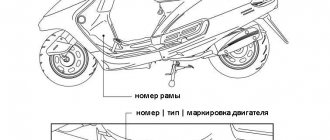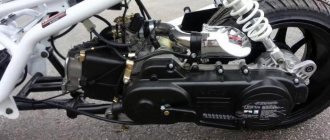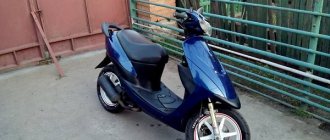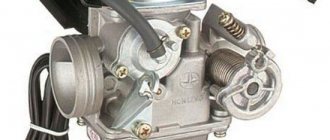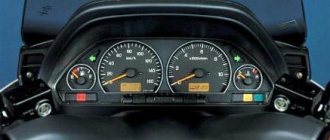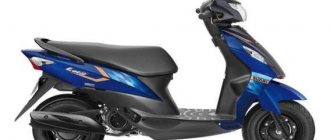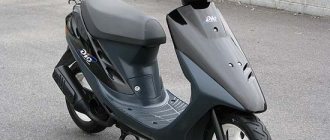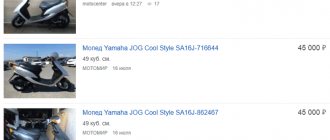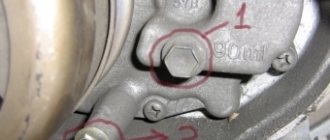- Why is verification needed?
- What data can you get about a motorcycle?
- What to do if the VIN code is missing?
- How to check in the AutoHistory service
Previously, the owner had to deregister the vehicle before selling it.
This allowed us to avoid many problems associated with the purchase of problematic vehicles. Now there is no need to deregister motorcycles; the presence of the seller at the traffic police is not required. This creates risks for buyers. If the transport has restrictions or encumbrances, it cannot be re-registered. And in some cases, confiscation of property is possible. To reduce the risks of buying a problematic vehicle, you need to have your motorcycle checked .
Determining the release date of the scooter
One of the frequently asked questions when buying a used scooter is, “what year is it?”
Let's try to figure this out.
You can find out the year of manufacture in two ways:
1. By frame number;
2. Find a table with the year of manufacture on the plastic of the scooter itself.
Of course, someone may say: “what if the plastic was replaced earlier and, accordingly, the year of manufacture table on the plastic does not correspond to reality?” for reinsurance in this case, you can use the first option and determine the year of manufacture by the frame number using a special table.
But what to do if such a table is not at hand, and the year of manufacture needs to be determined right now?
The answer is simple: - we are looking for a table with the year of manufacture on the plastic of the scooter itself, it looks something like this
The column on the left shows the year and the column at the top shows the month in which the scooter was released.
Actually, in which cell the dot is located and the date of issue. If there are several points, then you need to navigate by the last one.
These tables can be located in different parts of the scooter's plastic. Let me give you a few examples.
HONDATACT 50 (AF24) frame number: AF24-1057650, judging by the frame number it is 1989. We are looking for a table on plastic. For the HONDATACT 50 (AF24) model, this table is located on the inside of the front glove compartment lid.
We look at the sign. It turns out that this Tact was released in May 1989.
HondaTACT 50 (AF16) frame number: AF16-1080787, judging by the frame number it is 1987.
The table on the HondaTACT 50 (AF16) is located under the seat. Judging by the table, the release date is May 1987.
On Honda DIO 50 mopeds, most often the table with the date is indicated on the plastic cover that covers the gas tank (next to the fuel tank). The Honda DIO 50 (AF18) is an exception; its table with the date is located in the same place as the HondaTACT 50 (AF16), i.e. under the seat.
HondaGIORNO 50 (AF24). In GIORNOAF24, the table is located under the plastic that covers the battery on the tray.
The same situation applies to the Suzuki Lets 50 (CA41A). The table with the release date is located under the plastic on the cover.
Honda CREA SCOOPY 50 (AF55), the location of the table with the release date in this case is approximately the same as that of the Honda DIO 50, i.e. on the back of the cover that closes access to the gas tank.
After looking at options for 20 different mopeds, I realized that in most cases the year tables are located in approximately the same places.
Most often, tables with the release date of the scooter are located in the following places:
2. if there is a front glove compartment, then on the inside of the plastic that covers the glove compartment;
3. under the plastic on the tray if the battery is located in the tray;
4. on the inside of the cover that blocks access to the gas tank, if it is, for example, a HondaDIO scooter.
Call center 24 hours. Any questions from those. consultations to assistance with placing an order.
Warranty on all products
Warranty for goods from 6 months to 3 years. If there is a defect, we will replace the product without any questions asked.
Secure payment methods
Pay by credit card, PayPal, bank transfer or cash upon delivery.
Delivery throughout Russia
You can choose delivery by courier, Russian Post or at a pick-up point.
We will pack it well, send it for delivery and monitor the order until delivery.
What to do if the VIN code is missing?
The absence of a VIN number occurs on motorcycles from Japanese manufacturers. In this case, the documents indicate “Not installed”. But this means that the vehicle does not have an individual code. The frame number is used for registration and verification.
This value can be used when contacting the traffic police database.
It happens that the VIN code is erased or lost if the plate comes off. It is not advisable to buy such a vehicle - problems will probably arise during re-registration with the traffic police. Also, you should not try to restore the number or install a sign yourself. This will be considered an attempt to change the VIN. And to prove your innocence, you will have to order a legal review.
Another reason for the lack of an identification number is the seller’s refusal to provide this information. You can get the coveted numbers when inspecting the bike. If you were unable to photograph the sign, ask the seller to send the code. Even owners who have nothing to hide do not refuse this request.
To obtain information about the vehicle, you can use the state number. True, not everywhere there is such an opportunity.
Engine markings for Chinese scooters! Let's sort it out piece by piece.
Each motor of “rice” scooters has its own marking, which encodes the features of a particular unit. During scheduled scooter repairs (or unscheduled ones), many owners encounter some difficulties in finding spare parts, because they search for the main parts by the model name and not the engine marking. To do this, I recommend that you carefully examine the scooter’s engine, and after washing it of oil and dirt, find engraved numbers and Latin letters there. Most often, the location of these inscriptions is in two places:
- on the crankcase, underneath the cover, in the area of the front variator
- engraving in the gearbox area, also located on the engine crankcase.
Quite often I see how on forums and thematic groups on social networks, fans of the Chinese motorcycle industry argue that, for example, 152QMI and 157QMJ are different engines in principle. Let's figure out what all these numbers and letters mean. The first digit “ 1 ” ( 1 39QMB) in the marking will indicate that the engine has 1 cylinder. If you suddenly see the number “2” - go nuts, the scooter’s engine is two-cylinder. The letter “P” (1P39QMB) indicates that the cylinder is in a horizontal position. If the letter “P” is missing, then the cylinder on the scooter is not necessarily horizontal. So 139QMB and 1P39QMB, whatever one may say, are the same engines. The next two digits in the designation are “39”, “ 52 ”, etc. (1 52 QMI) denote the internal diameter of the cylinder liner, and accordingly the diameter of the piston and rings in the piston group. The first letter speaks about the scooter’s cooling system: “F” (139FMB, 1P39FMB) - air cooling of the motor occurs by free flow;
“Q” (139QMB, 152QMI, 157QMJ) - forced air cooling, there is a blower casing on the cylinder. If the letter is missing, the engine is most likely water-cooled (172MM - CH250). The second letter is the engine type: “M” (139QMA, 139FMA) - motorcycle engine. The third letter in the marking corresponds to the working volume of the cylinder-piston group of the scooter: “A” - up to 50 cubic meters (139QMA) - “honest” fifty dollars); “B” - up to 70 cubic meters (139QMB) - the most common, “almost honest” half-shock, which according to the rules should be labeled as 147QMB or even 150QMB;
"G" - up to 100 cubes; “H” - from 100 to 125 cubes (a rare variety of the GY6 family);
“I” - from 120 to 130 cubic meters (152OMI);
“J” - from 150 to 155 cubic meters (157QMJ);
“M” - up to 250 cc (172MM) - Chinese dropsy clone of Honda Spacy / Freeway with CH 250 engine.
Engines of the ARN family are also often found, with markings such as 153QMI, 157QMJ-H, 158QMI. Such engines are installed on Keeway and Stels scooters. They are often confused with the GY6 152QMI and 157QMJ family, both in the cylinder-piston group and in the cylinder head and all other parts of the engine. Although they are visually similar (152qmi-153qmi and 157qmj-158qmj), when purchasing spare parts it is worth checking these details with the seller. Concluding the “debriefing” on the dispute about 152QMI and 157QMJ, I would like to add on my own behalf that the engine data differs only in the cylinder displacement (52.4 mm and 57.4 mm). And such engines can also be called 1P52QM and 1P57QMJ.
Why is verification needed?
You need to check your motorcycle for the following reasons:
- The mileage can be inflated, which is done to inflate the cost of transport and hide the picture of the real condition of the bike. Knowing the mileage, you can assess the condition of the motorcycle and understand whether the seller is asking too high a price.
- The presence of restrictions in registration actions and encumbrances imposed by the bank prohibit the re-registration of transport.
- If the vehicle is pledged for a loan, then if you refuse to repay the debt, the property will be confiscated.
- It is important to make sure that the bike has not been stolen. Otherwise, the property is confiscated and returned to the real owner.
- Participation in serious road accidents causes technical malfunctions that affect the quality of transport and its operational characteristics.
- Find out the number of owners. If the vehicle often changes owners, the reason may be due to technical faults.
Knowing the VIN code, you can ensure that the vehicle is legally clean and that there is no serious damage to parts.
Engine markings of Chinese scooters
Chinese scooter engines can be two-stroke or four-stroke. All of them are produced directly in China by the scooter manufacturer or on order from a third-party company. Usually, no one is involved in the development of something new, since it is expensive, time-consuming and requires noble minds, of which there are not very many in this country.
Hence, all production lines are Japanese originals or slightly modified conveyors. Simply put, the engine that is on your Chinese scooter was on a Japanese Yamaha, Honda or Suzuki 15-20 years ago.
It is interesting that four-stroke engines better than two-stroke engines, hence their quality is somewhat higher. This means that a Chinese-made chotiritactic will be more reliable than two-stroke ones. There are also analogues of European models from the 80s and 90s, but there are very few of them.
Each engine of a Chinese scooter has markings that can tell a lot. A set of letters and numbers will tell you about the manufacturer's plant, the number of cylinders, cylinder location, piston diameter, combustion chamber volume and much more.
How can the police help?
From the point of view of checking for arrest or theft, the police have no reason to carry out such actions. This is the prerogative of the state traffic inspectorate. You should contact the police if your iron horse is stolen. In this case, you should make sure that the situation listed below does not occur.
- Due to violation of parking rules, the vehicle was evacuated from the impound lot.
- The owner is looking for his scooter in a place where he did not leave it. The reason is forgetfulness.
- The evacuation occurred due to ongoing road work.
- The moped was taken by the owner's relatives.
In other cases, you should write a report about the missing scooter as quickly as possible so that the police can take the necessary actions.
MOTOCROSS.UA
You can use your account to register and login:
how to find out the year of a motorcycle
Moderator: Neposeda
The Vehicle Identification Number (VIN) is composed of 17 characters. The standard was originally defined in ISO Standard 3779 in February of 1977. Then it was revised in 1983. The ISO VIN is designed to identify motor vehicles of all kinds: cars, trucks, busses, motorcycles etc.
The Vehicle Identification Number (VIN) contains three major sections:
* WMI - World Manufacturer Identifier (1,2,3 characters in VIN structure) If the manufacturer builds less than 500 vehicles per year than the third digit is “9”. The WMI is described in detail in ISO 3780. * VDS - Vehicle Description Section. It contains 6 characters (4th to 9th positions in VIN) and defines vehicle attributes specified by manufacturer. * VIS - Vehicle Identifier Section. The last 8 characters of VIN define Year, manufacturer plant and serial (sequential) number of the vehicle.
The last four characters shall be numeric. The 10th position of the Vehicle Identification Number is a YEAR CODE.
ISO recommends that in VIN code capital letters A to Z and numbers 1 to 0 may be used, excluding I,O and Q in order to avoid mistakes of misread. No signs and spaces are allowed in Vehicle Identification Number code. ***********************************************
Recap with examples:
Digits 1,2,3 are World, Manufacturer, Identifier Digits 4,5,6,7,8 are Vehicle descriptor Section — *Somewhat variable based on manufacturer. Digit 9 is the check digit Digit 10 is the Year code Digit 11 is the Factory code Digits 12,13,14,15,16,17 are the Vehicle Identification Sequence
Let's see how this splits:
First digit — Country code USA(1 or 4), Canada (2), Mexico (3), Japan (J), Korea (K), England (S), Germany (W), Italy (Z)
Second digit - Manufacturer Audi (A), BMW (B), Buick (4), Cadillac (6), Chevrolet (1), Chrysler (C), Dodge (B), Ford (F), GM Canada (7), General Motors (G), Honda (H), Jaguar (A), Lincoln (L), Mercedes Benz (D), Mercury (M), Nissan (N), Oldsmobile (3), Pontiac (2 or 5), Plymouth (P), Saturn (8), Toyota (T), Volvo (V), Suzuki (S), Kawasaki (K).
Third digit — Identifier Motorcycle (1 or A) Kawasaki and Suzuki seem to follow this anyway
Fourth digit — Vehicle category Data here is Suzuki specific, haven't found info for other brands. Scooter (C), Business model or commuter (B), Single cylinder sport/street (N), Multiple cylinder sport/street (G), Family (F), Off road (S), V-Type engine, street, V2 /V4/V6/8. (V), Square Four (H)
Fifth digit — Engine Displacement Data here is Suzuki specific, haven't found info for other brands. A=49cc and less B=50-69cc C=70-79cc D=80-89cc E=90-99cc F=100-124cc G=125-149cc H=150-199cc J=200-249cc K=250-399cc M=400-499cc N=500-599cc P=600-699cc R=700-749cc S=750-849cc T=850-999cc U=1000-1099cc V=1100-1199cc W=1200-1299cc Y=1400-1499cc Z=1500&up
Sixth digit — Engine Type Data here is Suzuki specific, haven't found info for other brands. 1=2 stroke single 2=2 stroke twin 3=2 stroke triple or four 4=4 stroke single 5=4 stroke twin 6=? 7=4 stroke four
Seventh digit Data here is Suzuki specific, haven't found info for other brands. Design sequence or model version first version uses 1 then second version uses 2 etc. the tenth version would then be identified by the letter A then B etc..
Eigth digit Data here is Suzuki specific, haven't found info for other brands. First version uses 1 then second version uses 2 etc. the tenth version would then be identified by the letter A then B etc.
Ninth digit — Check digit The ninth vehicle identification number digit is a VIN accuracy check digit, verifying the previous VIN numbers. This is how the check digit works
STEP 1 Assign to each number in the VIN its actual mathematical value and assign to each letter the value specified for it in the following chart: ASSIGNED VALUES: A=1 G=7 P=7 X=7 B=2 H=8 R =9 Y=8 C=3 J=1 S=2 Z=9 D=4 K=2 T=3 E=5 M=3 U=4 F=6 N=4 V=5
STEP 2 Multiply the assigned value for each character in the VIN by the position weight factor specified in the following chart: VIN POSITION AND WEIGHT FACTOR: 1st = 8 10th = 9 2nd = 7 11th = 8 3rd = 6 12th = 7 4th = 5 13th = 6 5th = 4 14th = 5 6th = 3 15th = 4 7th = 2 16th = 3 8th = 10 17th = 2 9th = check digit
STEP 3 Add the products from steps 1 and 2 and divide the total by 11.
STEP 4 The numerical remainder is the check digit which would appear in the 9th position in the VIN. If the remainder is 10, then the letter “X” is used for the check digit.
Eleventh digit — Factory Code Manufacturer code for what plant it was built in
Honda Live Dio AF-34/35 scooter review
The third generation of Dio scooters, the Honda Live Dio (AF-34), entered production in 1994. Unlike the similar Dio AF-18 and Super Dio AF-27, this model received noticeable changes, such as the new AF34E engine, which had a horizontal cylinder. In addition to the engine, the chassis has also changed. The scooter has received a new beautiful design with streamlined shapes, as well as crystal optics. For the first time, the underseat trunk has a flat floor.
The following versions of Live Dio were produced: basic (AF-34) with drum brakes, AF-34 Cesta - with a built-in front luggage basket, AF-35 SR - with a front disc brake, AF-35 SR CB (Combi Break) - with a combined braking system, AF-35 ZX - a sports version with oil shock absorbers, alloy wheels, a forced engine and a spoiler. In addition, the line included the AF-35 ST model with anti-lock brakes.
The Honda Live Dio series underwent a redesign in 1998 and was produced until 2004.
Specifications
Engine: Engine type – AF34E, displacement 49 cc. see Number of cylinders – 1. Number of strokes – 2. Cooling system – forced air cooling. Maximum engine power – 7.2 hp. at 6500 rpm. Torque – 0.81 kg*m / 6250 rpm. Compression ratio – 7.1. Transmission – variator. Ignition - electric starter. The tire size of the front and rear wheels is 3.00-10. Oil tank volume – 1.2 l. Gas tank volume – 5.3 liters. Maximum speed – 60 km/h.
Chassis:
The front wheel suspension type is telescopic. The rear wheel suspension type is pendulum. Front wheel brake type – drum/disc (SR/ZX). The rear wheel brake type is drum.
Size and weight:
Base – 1145 mm. Length – 1675 mm. Seat height – 700 mm. Ground clearance – 105 mm.
Total weight – 70 kg.
Features and Benefits
The Honda Live Dio series continues its line of city scooters. Although both the engine and chassis are now completely different. Externally, the scooter has acquired a new look, with crystal optics and a streamlined body kit.
AF-34 is even more playful than previous series. Riding such a scooter in the city is a real pleasure. Carrying things has also become easier: the underseat trunk now has a flat floor. The front has a hook for bags and a pocket for small items. And the AF-34 Cesta version has a front cargo basket (the headlight on the Cesta is located under the basket).
The AF-35 SR CB series uses the CombiBreak combined braking system for the first time. The essence of its work is to distribute the braking force when braking with the front brake: 30% of the force is transferred to the rear brake and 70% to the front
This significantly increases stability when braking, which is especially important for inexperienced drivers
The sports version of the AF-35 ZX deserves special interest. Its suspension compares favorably with previous models, since the scooter is equipped with more comfortable and more durable oil shock absorbers instead of spring shock absorbers. The front fork travel is 95 mm. Therefore, off-road is no longer such a big problem for the AF-35 ZX. To improve dynamics, the scooter's transmission has been retuned: lighter weights are used in the variator, and stiffer springs are used in the clutch. It is also worth mentioning the front disc brake, sports muffler and beautiful alloy wheels. Well, as usual, the sports version has a spoiler with an LED brake light.
The scooter is equipped with a footrest blocker (anti-theft device).
Live Dio has retained all other advantages - reliability, ease of repair (although access to the piston group now requires significant disassembly), and availability of spare parts. Thanks to the boosted engine (7.2 hp - a record for 50 cc scooters), it has become even easier to tune the scooter.
The transmission of all Honda scooters is simple and reliable: torque is transmitted using a V-belt variator. The driver does not need to worry about changing gears, there are simply none here, so acceleration always occurs without failures and without slowdowns.
Honda Live Dio is Honda's latest range of scooters with a two-stroke engine.
Please note: This article and the images in it are subject to copyright. Partial or complete reproduction on other resources without permission is prohibited
scooter777.ru
Operation, maintenance and repair
Honda Today is a fairly repairable scooter. All that needs to be done to get to the main components is to remove the decorative plastic, but if the plate itself was damaged, the part will have to be completely replaced. Servicing a variator also costs a certain amount, and not everyone can repair it. By the way, Honda Today is absolutely not afraid of moisture, because all the main components are reliably protected from water by plastic.
In order for a scooter to serve for a long time and trouble-free, it is important not only to be able to repair it, but also to ride in such a way that repairs are required as rarely as possible. New equipment must be tested before everyday use.
The running-in period of the Honda Today literally determines the future fate of the scooter, because it allows you to get used to the operating features of the engine and main components. During break-in, do not heavily load the scooter and ride with the throttle fully raised. These recommendations should be followed during the first 1000 km of driving, so as not to deteriorate the performance of the Honda Today in the future.
Replacing consumables
All modern scooters use two types of oil - motor and transmission. It is not recommended to use low quality oil. It is preferable to fill in synthetic rather than mineral oils. In order for all components to work correctly, it must be changed regularly - on average once every 3000 km, if a high-quality consumable is used. During the break-in period, the oil needs to be changed more often.
Honda Today is not afraid of water
Typically, the replacement frequency looks like this:
- After the first 300 km.
- After 1000 km.
- After 2000 km.
- Then the oil is changed every 2-4 thousand kilometers, as necessary.
Transmission oil can be changed less frequently, approximately every 4-6 km.
It is very important to pay attention to the air filter. The filter element needs to be replaced, but you can simply extend its life: wash it in gasoline and treat it with a special product. A poorly impregnated filter will not clean the air well.
If you often drive on dusty dirt roads, you need to change the filter more often.
A poorly impregnated filter will not clean the air well. If you often drive on dusty dirt roads, you need to change the filter more often.
Every year before the start of the summer season, all cables and joints should be lubricated, and the fuel filter should be replaced with a new one.
It is important to pay special attention to the air filter on a scooter.
Ignition installation
Without an ignition system, it is impossible to move a vehicle with a gasoline or diesel engine, so the quality of operation of the scooter will depend on it. The correct selection of spark plugs and adjusted ignition will allow you to start the scooter even in cold weather.
Before setting the ignition, you need to make sure that fuel enters the engine without problems. If necessary, clean the carburetor.
First you need to find the optimal position of the timing star on the Honda Today. This is done simply - there is a letter “T” on the star, which should coincide with the protrusion on the crankcase. The procedure is performed either manually or using a kickstarter.
